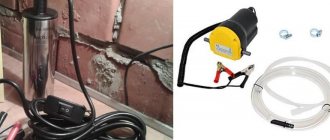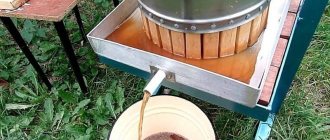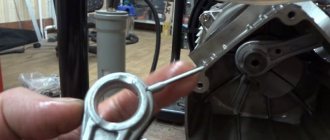Retail chains offer us the familiar well-known product, sunflower oil, in a fairly wide range. The oil offered varies in grade, type, quality, price, production and processing methods. Not everyone, however, is confident in the quality of the industrially produced goods offered, since manufacturers often use some unhealthy substances in the process, the remains of which may be in the final product. Some manufacturers also add dyes and stabilizers (you don’t want this kind of oil at all, much less cook with it for children).
But there is a way out (for those who are diligent).
You can prepare high-quality cold-pressed sunflower seeds at home; the basic recipe is simple. So you need to find high-quality seeds of varieties suitable for processing. For those who are going to constantly make sunflower oil at home, it makes sense to purchase or make-order some devices. Beginners can get by with more familiar or homemade primitive kitchen devices.
How to make sunflower oil?
We'll tell you how to squeeze and store sunflower oil at home.
The general principle for obtaining homemade sunflower oil is as follows: the seed must be peeled, squeezed out the oil, filtered and/or cleaned in another way.
In serious home production, calibrators (seed cleaning devices), oil presses and various filters are used to clean seeds.
To obtain sunflower oil in small quantities, the seeds can be cleaned with a seed mill and processed in a grinder (or using a blender, food processor, or meat grinder). Then pour the mixture of seeds and husks with cold water so that the unnecessary husks float up (this process is called hydroflotation). After removing the husks, throw the mixture of seeds and water onto a sieve and let the water drain.
In another option, if you can thoroughly peel the grains from the husks before squeezing, then after squeezing the grain mass will turn into a cake, to which you can add sugar syrup or honey - you will get an excellent halva. Hydroflotation is not necessary in this type of process.
Do not use ready-made peeled seeds - the oil will taste bitter.
Now squeeze out the oil. By the way, there are attachments for meat grinders for separating juices from pulp, which are very suitable for our purposes. Or you can make your own press from a small aluminum pan. Drill several holes along the bottom of the pan closer to the center to drain the oil. In the center of the bottom we drill a hole for a long thick bolt and secure it firmly (with a nut). We use a wooden circle with a hole for a bolt as a piston. Think about further improvements yourself. Screw a nut on top of the mug.
Place the mass from which we will press the oil into a press and tighten the nut with a convenient wrench, taking your time. As the oil drains, we tighten it a little more... and a little more, and until it stops. Of course, under the press there is a container into which the oil flows.
Now the oil can be filtered. It’s even better to first freeze the oil in a powerful freezer at a temperature no higher than – 15°C, and then filter it, this way we will also remove any remaining water.
It is best to store oil in dark beer bottles filled to the top, sealed tightly, away from light, in a cool place.
Retail chains offer us the familiar well-known product, sunflower oil, in a fairly wide range. The oil offered varies in grade, type, quality, price, production and processing methods. Not everyone, however, is confident in the quality of the industrially produced goods offered, since manufacturers often use some unhealthy substances in the process, the remains of which may be in the final product. Some manufacturers also add dyes and stabilizers (you don’t want this kind of oil at all, much less cook with it for children).
But there is a way out (for those who are diligent).
You can prepare high-quality cold-pressed sunflower seeds at home; the basic recipe is simple. So you need to find high-quality seeds of varieties suitable for processing. For those who are going to constantly make sunflower oil at home, it makes sense to purchase or make-order some devices. Beginners can get by with more familiar or homemade primitive kitchen devices.
How to make sunflower oil?
We'll tell you how to squeeze and store sunflower oil at home.
The general principle for obtaining homemade sunflower oil is as follows: the seed must be peeled, squeezed out the oil, filtered and/or cleaned in another way.
In serious home production, calibrators (seed cleaning devices), oil presses and various filters are used to clean seeds.
To obtain sunflower oil in small quantities, the seeds can be cleaned with a seed mill and processed in a grinder (or using a blender, food processor, or meat grinder). Then pour the mixture of seeds and husks with cold water so that the unnecessary husks float up (this process is called hydroflotation). After removing the husks, throw the mixture of seeds and water onto a sieve and let the water drain.
In another option, if you can thoroughly peel the grains from the husks before squeezing, then after squeezing the grain mass will turn into a cake, to which you can add sugar syrup or honey - you will get an excellent halva. Hydroflotation is not necessary in this type of process.
Do not use ready-made peeled seeds - the oil will taste bitter.
Now squeeze out the oil. By the way, there are attachments for meat grinders for separating juices from pulp, which are very suitable for our purposes. Or you can make your own press from a small aluminum pan. Drill several holes along the bottom of the pan closer to the center to drain the oil. In the center of the bottom we drill a hole for a long thick bolt and secure it firmly (with a nut). We use a wooden circle with a hole for a bolt as a piston. Think about further improvements yourself. Screw a nut on top of the mug.
Place the mass from which we will press the oil into a press and tighten the nut with a convenient wrench, taking your time. As the oil drains, we tighten it a little more... and a little more, and until it stops. Of course, under the press there is a container into which the oil flows.
Now the oil can be filtered. It’s even better to first freeze the oil in a powerful freezer at a temperature no higher than – 15°C, and then filter it, this way we will also remove any remaining water.
It is best to store oil in dark beer bottles filled to the top, sealed tightly, away from light, in a cool place.
Homemade vegetable oil is valued for its naturalness and healthiness: it contains many vitamins, enzymes, and unsaturated fatty acids. In addition, it has amazing taste properties, because vegetable oil obtained at home is always fresh and aromatic . Homemade oil presses allow gourmets to enjoy types of oils that are rarely found in stores: sesame, hemp, peanut, poppy seed. And ordinary sunflower oil, made at home, is much healthier and tastier than store-bought.
Meanwhile, preparing vegetable oil at home is quite simple - you just need to acquire the necessary equipment that will do the bulk of the work.
Tools for extracting oil at home
There is an opinion that oil can be extracted only with the help of professional, bulky and expensive equipment that will occupy half a room. Actually this is not true. household oil presses on the household appliances market for a long time - they are very compact, autonomous and can effectively handle most types of seeds. Household oil presses cost an average of 15 to 30 thousand rubles.
So, the first thing we need to get homemade oil is a household oil press . It can be manual or electric. Manual devices are less efficient and require a lot of effort and patience, but they are cheaper. Electric devices allow you to comfortably enjoy the process of squeezing homemade oil: you just need to carefully feed the seeds into the loading neck. Such devices are somewhat more expensive.
The function of adjusting the heating temperature of the oil press will be useful. Not many devices have this feature. One example of a home oil press with temperature control is the Dream Modern home appliance from the manufacturer RawMID. Therefore, we decided to make this review using this particular model. Its cost is about 18-19 thousand rubles.
The oil press kit already contains everything you need to obtain homemade vegetable oil: a funnel for loading seeds, a protective thermal glove, a brush for cleaning parts, as well as two containers - for the cake and the oil itself . The equipment of other oil presses may vary, but the listed accessories are necessary.
Now all that remains is to stock up on seeds from which we will make homemade vegetable oil: sunflower, flaxseed, sesame, hemp, peanut. whatever! Of the popular types of oils, household oil presses do not squeeze out only olive oil.
Industrial oil extraction
All modern oil presses can be divided into devices that perform preliminary and final pressing of raw materials.
The installations with which preliminary extraction is carried out are called forepresses, and the process of preliminary extraction itself is called prepressing. Sometimes manufacturers squeeze the oil out of the seed in one pressing, but in other cases, taking into account the type of raw material, they also have to use a final pressing, for which they use pressing equipment that is made specifically for this stage. The screw fortpress consists of the following parts:
- bed;
- screw;
- Zeer box;
- electric motor;
- dosing input device;
- an automatic control system for oil extraction processes, which is responsible for the operation of the entire apparatus.
The spin technology is simple. At the first stage of work, it is necessary to prepare the raw material mass for this process. Some types of raw materials require heat treatment in special fryers, due to which the yield of oil during pressing and its qualitative composition significantly increases, while others are pressed cold.
Oil extraction technology in a home oil press
- ► Turn on the oil press and warm it up for 5 minutes.
- ► Add seeds gradually.
- ► The oil will flow into the container provided.
This algorithm applies to sunflower, sesame, peanut and many other vegetable oils. Using an oil press without warming up not only risks a low percentage of extracted oil, but also possible failure of the device.
As a rule, the higher the heating temperature, the greater the spin efficiency. In our model - RawMID Dream Modern - heating is possible up to 180°C.
Let's take a closer look at how to make sunflower, flaxseed and other oils at home.
Sunflower oil at home
Perhaps this is the most common and well-known type of vegetable oil that can be found in any grocery store. But when a store-bought product becomes completely boring with its low quality, you involuntarily ask the question: how to make homemade sunflower oil? After all, you want it to be more tasty, healthy and of higher quality. Fortunately, with the help of an oil press this is not at all difficult.
First of all, choose suitable raw materials : it is advisable to choose seeds of the highest quality possible - whole, without husks, cracks or other damage.
To prepare sunflower oil at home, you need to do the following:
- 1. Dry the seeds (20 minutes at t≈100°C) and peel them.
- 2. Warm up the oil press to 100-150°C.
- 3. Gradually add seeds following the instructions. It is recommended to use the special funnel included in the kit.
- 4. Make sure the auger rotates freely. The cake should come out dry, and the oil should drain into a substitute container.
When squeezing 100 grams of dry sunflower seeds at home, you can get up to 47 grams of oil (the efficiency of an oil press is up to 98%, if you count the total oil content in the product). If you warm up the oil press minimally, the oil yield will be about 13 grams.
Homemade sunflower oil is head and shoulders above store-bought oil in terms of quality . In industry, oil from sunflower seeds is squeezed out using extractors - special industrial installations. The seeds are first dried with carbon monoxide. To increase the efficiency of pressing, organic solvents (usually benzene-based) are added to the seeds. And to clean the oil from these solvents, the raw material is then heated to 250°C. There should be no solvent left in the final product. And even if there is gasoline in microscopic doses in the oil, then most likely it will not have a fatal effect on the body.
At home, sunflower oil is obtained naturally without the use of any chemicals. Drying a small volume of seeds is carried out in an oven or in a dehydrator (drying in it takes place in a gentle mode at low temperature). At the outlet, the oil temperature can vary from 35 to 50°C, depending on the degree of heating of the oil press.
The productivity of the Dream Modern home oil press in our experiments was 3.9 kg/hour (with preheating of the device to 100°C). That is, in 1 hour you can squeeze about 1850 grams of sunflower oil from 3.9 kg of seeds.
After the pressing process is completed, the resulting oil can be filtered through cheesecloth or wait until the particles precipitate: the oil will become lighter in color and will contain almost no solid particles.
100-200 rubles (depending on how much you buy the seeds for), while in the store natural cold-pressed oil costs about 250-300 rubles.
As you can see, the process of preparing sunflower oil at home is very simple, fast and economical. And the result is natural sunflower oil, rich in nutrients.
Hemp oil at home
You can rarely find such oil in stores. Meanwhile, it is very healthy, as it is rich in vitamins, antioxidants and phytosterols, and is superior to flaxseed oil in terms of the content of polyunsaturated fatty acids omega-3 and omega-6. By the way, contrary to some myths, hemp oil obtained from seeds is absolutely safe and does not contain any narcotic substances (they are found only in the leaves and stems of hemp).
Making hemp oil at home is almost as easy as making sunflower oil. The only caveat is that you can’t do this without heating the oil press to 100°C, otherwise the oil won’t even flow.
Algorithm for obtaining hemp oil in a home oil press:
- 1. Dry the seeds (30 minutes at t
100°C).
- 2. Warm up the oil press to 100-150 °C.
- 3. Gradually, teaspoon by teaspoon, load the seeds into the loading hole. Be sure to use the included funnel.
- 4. Make sure that the auger rotates normally and the oil flows into the container provided.
As you can see, a household oil press allows you to easily obtain even rare types of oils, such as hemp oil, at home. And the video below demonstrates a test of the performance of an oil press when producing sunflower and hemp oil with different temperature settings.
Flaxseed oil at home
Flaxseed oil is sold in some supermarkets, but few people know that when buying this oil in a store, we take a big risk. The fact is that when heated strongly, linseed oil quickly deteriorates and becomes rancid. This not only negatively affects the taste of the product, but also makes it hazardous to health.
How to be? Fortunately, the solution is quite simple: with the help of a household oil press, absolutely anyone can now make flaxseed oil at home - easily, quickly and safely. The main thing is not to violate the conditions for its subsequent storage (more on this a little later).
Properly prepared, flaxseed oil is extremely beneficial : it is a rich source of omega-3 polyunsaturated fatty acids, such as alpha-linolenic acid. Flaxseed oil is very beneficial for the cardiovascular system: it lowers cholesterol levels, reduces high blood pressure, and is effective in preventing heart and vascular diseases. Flaxseed oil also improves the absorption of iodine by the body, which has a positive effect on the immune system.
Usually, to extract linseed oil at home, it is recommended to heat the oil press to a high temperature of about 150°C. However, high temperatures accelerate the rancidity of oil and significantly reduce its shelf life. Having a Dream Modern oil press in our hands with the ability to select the heating temperature, we decided to try squeezing linseed oil at 35°C (with preheating to 80°C). Result: from 250 grams of flax seeds we got 84 grams of oil. Quite a good result, considering that during spinning the temperature of the screw did not exceed 47°C, and the oil temperature at the outlet was 26-27°C. This oil can be safely called cold-pressed oil. This is the method we recommend using to obtain flaxseed oil at home.
What should be done:
- 1. Dry the flax seeds.
- 2. Warm up the oil press to 80°C
- 3. Set the temperature to 35-40°C.
- 4. Gradually, a little at a time, load the flax seeds into the oil press. Be sure to use the included funnel!
- 5. Control the spin progress: the auger should rotate freely and not make any extraneous sounds. If something goes wrong, turn off the device, clean it, and then try spinning again at a higher temperature (for example, at 50°C).
This is how you can get natural and absolutely safe flaxseed oil at home quite quickly and with high efficiency.
Homemade sesame oil
This type of oil is very rare and at the same time not the cheapest, but it still has a certain popularity for its beneficial and tasteful properties. It is rich in amino acids, polyunsaturated fatty acids, vitamins A, E, D, B1, B3, C, micro- and macroelements: potassium, magnesium, calcium, phosphorus, zinc, iron, manganese. It is especially popular in recipes for Asian cuisine (Indian, Chinese, Korean, Japanese). It is also used for the treatment and prevention of diseases of the digestive and cardiovascular systems.
Using an oil press from 100 grams of sesame seeds, we were able to obtain 23 grams of oil by cold pressing - a decent result, considering that we tried to preserve the maximum amount of nutrients in the product. The temperature of the grinding chamber during spinning was kept at about 33°C, and the oil ultimately did not heat up above 30°C.
So, what you need to do to get sesame oil at home:
- 1. Dry the sesame seeds.
- 2. Warm up the oil press to 80°C.
- 3. Set the spin temperature to 35-40°C
- 4. Gradually, a little at a time, load the seeds into the oil press. Use the funnel included in the kit.
- 5. Make sure that the oil press does not make any extraneous sounds and that the process proceeds normally. If something is wrong, turn off the oil press, clean it, and then try again at a higher temperature.
Now you know that preparing any vegetable oil at home is very easy and simple using a household electric oil press.
After you have pressed the oil, it must be stored properly. Let's see how to store different types of homemade oil so that it does not lose its beneficial properties.
Spin methods
Before choosing oil extraction devices, you need to decide what type of oil product you are targeting. There are two ways to obtain this sought-after liquid.
- Hot pressed oil. Before squeezing, the mushy mass is heated to a temperature of 110 degrees Celsius. At the same time, the mint is moistened and mixed in roasting pans. After this, the screw mechanism compresses the raw materials. The hot-pressed product has the taste of roasted sunflower seeds. This oil is darker, has an attractive color and an amazing aroma.
- Cold pressed oil. Cold-pressed products are considered more useful, since some properties and useful components of the raw materials are not lost when heated. The essence of cold pressing is the absence of the stage of heating the raw materials. Cold-pressed liquid retains all the beneficial substances and vitamins. But the shelf life is lower. Over time, the oil darkens and acquires a bitter taste.
Flaxseed oil in cosmetology
Nourishing and moisturizing mask with linseed oil - option No. 1
Nourishing and moisturizing mask with linseed oil - option No. 2
Nourishing and moisturizing mask with linseed oil - option No. 3
Hand mask with linseed oil
Mix 2 teaspoons flaxseed oil, 1 egg yolk, 1 teaspoon honey and 1 teaspoon lemon juice. Apply the mask to the skin of your hands for 30 minutes before going to bed, then rinse with warm water.
So, we looked at the technology for squeezing various vegetable oils at home, the tools necessary for this, as well as the storage conditions for homemade oil and several cosmetic recipes. As you can see, there is nothing complicated about this. We hope this article helps you eat healthy!
Photo shop: how cold-pressed vegetable oil is pressed
I received a question from Instagram about the cold-press technology of EcoFarm YAKUSHEV. A good question deserves a good answer and gratitude, so we provide a link to the author’s profile: rodnoy_medok
Question from rodnoy_medok: Tell us how you can fry using extra cold-pressed oil?) After all, there are only three methods of extraction - an oak barrel, a screw press and extraction. You can buy it from a screw press in a store - “cold” pressing and the smell of roasted seeds. Do you have the same?
The answer was prepared with the support of Alexey Yakushev: Dear rodnoy_medok, thank you for the wonderful question, because many people only know about the existence of refined and unrefined oil, and even unrefined oil can be different. So let’s put harmful refined oils aside and consider the technologies for the production of unrefined vegetable oil.
Like presses made from other types of wood, oak presses are very beautiful, and during the production process they emit an incomparable aroma and the oil flows so deliciously that you can admire it, but everything is so rosy only before they begin to be actively used.










